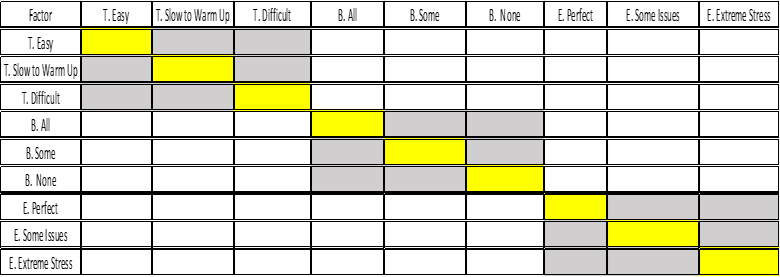
Helping Challenging Children
Understanding the "Whys" of Their Behavior
Why Don't Infants come with an Owner's Manual
Have you ever wondered why infants aren't born with an owner's manual?
It would be simpler to understand why an infant, child, or adolescent made the choices they did and to know how to respond if there was an owner's manual.
Of course, as a professional or parent, you have tried to find such manuals, but none were good fits.
The books seemed to address different problems than you were dealing with.
You used the responses recommended in the books for individual child behaviors. Unfortunately, they didn't achieve the same reaction as the book described.
Many children and adolescents receive labels that describe negative behaviors and emotional reactions due to the limited understanding of what impacts a child’s social, emotional, intellectual, and physical development.

The Three Factors That Make Up Children
Children have three core needs. Children are born wanting to be loved, accepted, and respected.
Sounds simple, doesn't it?
But infants, children, and adolescents aren't hard-wired to return love, acceptance, and respect.
We have to teach them.
To teach them, we need to realize that three factors affect their physical and emotional growth:
- Temperament
- Biology/development
- Environmental influences
These three factors affect different children in different ways.
To provide the best support for children, you need to understand each of these factors individually and in connection with the other two factors.
Do you know and understand each of these three factors?
Each child has these three factors, varying along a spectrum of effects on how they interact with adults and others.
Each factor is affected by how others interact with that factor and the other two factors.
The result can be a child who is calm, confident, and able to self-regulate their behaviors or a child who is always stressed, leading to an adult with issues in relationships, employment, and mental health.

This simplified grid shows the many possible combinations across the three factors.
T. Temperament
B. Biology
E. Environment
You can't have traits within a factor intersecting with other traits in the same factor.
Yellow is the same trait intersecting itself.
Gray is a trait in one factor, not being able to intersect with another in the same factor.
Who Needs to Understand These Factors?
Professionals working with children and adolescents need to understand how to integrate knowledge of these three factors into prevention and intervention actions to optimize a child's social, emotional, and physical growth.

Teacher
Being a teacher can be very gratifying but also very challenging.
The primary focus of teacher education at the college level is to master teaching the core subjects of reading, writing, and math, as well as other subjects built off of the core three.
All this education occurs in the last two years of college, including some time student teaching.
Some courses look at the issues facing schools and students. Still, they are likely not enough to help the teacher-in-training feel confident in recognizing and handling these individual differences while managing the rest of the classroom and meeting educational benchmarks.
Teaching the integrated approach of how the three factors impact the teacher and the student is not part of the curriculum.
Teachers have the most interaction with the biology factor which relates to education and some in environment due to the impact of home life on a student's ability to engage in learning.

Social Worker/Psychologist
There are two types of psychology: school and clinical. Most children who are challenging will come in contact with a school psychologist. Some may also work with a clinical psychologist regarding assessments and treatment for mental health problems.
School psychologists are required to be multitaskers. They must be experts in school systems, mental health, behavior, and learning. They interact with the school staff, especially with teachers of any challenging students. They may contact the parents sometimes, but their main focus is on how the student functions in school.
Clinical psychologists work outside of the school system, although they may interact if there are needs. Their focus is on the child or adolescent and the family, especially regarding mental health or behavioral issues.
Social workers can work in schools, private practice, government agencies, and medical centers. Their focus is understanding and supporting the client and family or caregivers. Social workers may provide some counseling services or help to put community services in place to lower the family system's stress.
While these professionals may have some knowledge of the three factors, there may not be a consistent focus on exploring each factor when addressing the challenges of the child or adolescent.

Pediatrician/psychiatrist
Pediatricians and psychiatrists are medical doctors, also known as physicians. Both interact with children and adolescents. Pediatricians focus on ensuring normal health and development, while psychiatrists help when there are mental health problems or disorders.
Both fields have subspecialists who work with challenging children and adolescents. In pediatrics, there are developmental and behavioral pediatricians (DBP). In psychiatry, there are child and adolescent psychiatrists (CAP).
There is an overlap between these two subspecialties regarding care, but their training reflects the differences in their disciplines.
DBPs is a three-year fellowship after completing a pediatrics residency. These physicians then receive additional training in the Biology and Environmental factors, plus most get training in the Temperament factor. The goal is to help their patients follow a positive social and emotional trajectory to adulthood.
CAPs is a two-year fellowship after completing a psychiatry residency. These physicians receive additional training in developmental issues such as autism, intellectual disorder, and ADHD, as well as disruptive behavioral disorders and more complex mental health disorders. The focus is on psychopharmacology and cognitive behavioral therapy.
Unfortunately, there are significantly fewer of these two subspecialists than those of general pediatrics and general psychiatry, as well as fewer than psychologists and social workers.
Are You Ready to Learn the Three Factors?
To understand children and adolescents, you need to go deep.
Behaviors and emotional reactions are not what you should respond to. They are the first clues in your journey to understand “why.”
Why did he blow up? Was his slow adaptability trait triggered?
Was his ADHD getting overwhelmed?
Did he have a blow-up with his mother, who had been out all night drinking before he came to school?
Or was it a combination of two or three of these issues?
Before you can assign a factor, you need to understand the spectrum nature of each factor. This knowledge is where the foundation course, Never Assume: Know Children Before Labeling Them, comes in.
Never Assume looks at each factor and the elements that make them up individually. It also teases what happens when one or both of the other factors is also reacting in the child.
Learn more about Never Assume by clicking the link below.


